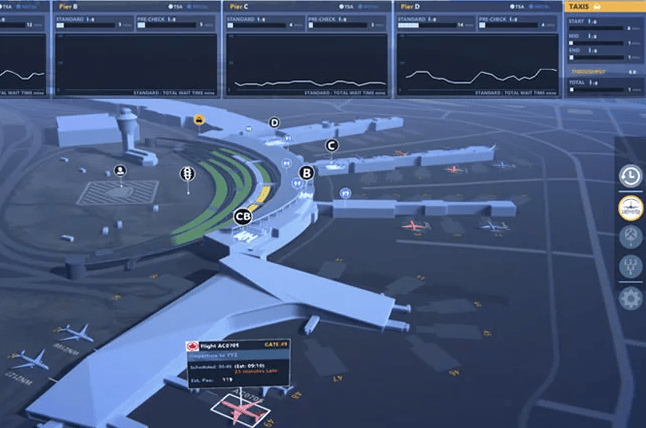Digital Twin-ception: How SITA is Building the Virtual Airport of the Future
Share

Digital twin technology could soon help airports improve aspects like security wait times and curbside traffic.
Modeling real-life systems and processes virtually using digital twins is increasingly common in the aviation industry. Until recently, the focus has been on improving production efficiency and performance in engineering processes, from parts manufacturing to aircraft design. With the technology’s rapid evolution, the potential applications are growing: fully-functional digital twins of entire airports could be just a few years away.
So, how do digital twins work? Engineers place sensors in key pieces of equipment in an environment they’d like to simulate. These sensors relay activity data into a virtual replica that processes and stores the information in real time. The data can then be analyzed to identify bottlenecks and other opportunities for optimization, and even forecast how unexpected changes might impact operations.
SITA Lab is currently working on a fully functional digital twin of a US East Coast airport. It’s still in development, but completion isn’t that far off. “The timeframe is five to ten years. The technology more or less exists now, but the data does not: the challenge is data acquisition,” said Kevin O’Sullivan, lead engineer at SITA Lab. “That is why a significant part of our Lab Digital Twin program is related to acceleration of data acquisition using technology like Computer Vision and LIDAR, to augment traditional IoT for telemetry acquisition.”
This data collection, which could include airfield activity, curbside traffic and security lane information, is happening bit by bit. “On the small scale, there will be multiple projects to increase telemetry coverage. Not all will be digital-twin focused, but any airport digitization or improvement project should have increased data output as one of its deliverables,” O’Sullivan explained.
“Simply having lots of data doesn’t automatically turn it into intelligence, automation or simulation.” – Kevin O’Sullivan, SITA Lab
The sheer possibilities of digital twin tech are incredible, but with big data comes big responsibility. Analysts will have to figure out what information is actionable, and what’s just noise. “Simply having lots of data doesn’t automatically turn it into intelligence, automation or simulation. It still takes a considered effort to figure out what we can predict that will actually be useful and actionable to continuously improve airport operations. This is where the data and domain knowledge converge,” according to O’Sullivan.
When digital twins become standard, airports will have an unprecedented database to draw from. Airlines and airports could pool their digital twin data across a shared network to optimize operational communications on a national or global scale: “There is scope to feed simulation output from airline digital twins into airport systems. We could have things like digital twins of aircraft engines feeding in to airline digital twins to improve maintenance and operations. In turn, they could feed into overall airline performance, feeding into airport systems and so on,” O’Sullivan said.
A truly interconnected and layered digital twin ecosystem is still a ways off, but O’Sullivan is already thinking about the possibilities ahead. Digital twins have the potential to completely transform how vendors market their goods and services: “The digital twin of digital twins concept will take time to evolve, but I expect vendors will start to compete not just on who has the best products, but who also has the most competent digital twins of those products.”


